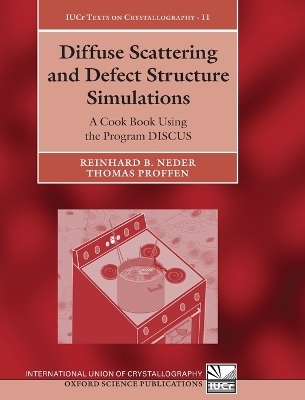
Diffuse Scattering and Defect Structure Simulations
Oxford University Press (Verlag)
978-0-19-923369-4 (ISBN)
In recent years it has become apparent that knowing the average atomic structure of materials is insufficient to understand their properties. Diffuse scattering in addition to the Bragg scattering holds the key to learning about defects in materials, the topic of many recent books. What has been missing is a detailed step-by-step guide how to simulate disordered materials. The DISCUS cook book fills this need covering simple topics such as building a computer crystal to complex topic such as domain structures, stacking faults or using advanced refinement techniques to adjust parameters on a disordered model. The book contains a CDROM with all files needed to recreate every example given using the program DISCUS. The reader is free to follow the principles behind simulating disordered materials or to get down into the details and run or modify the given examples.
Professor Reinhard Neder My MSc thesis at Arizona State University involved HRTEM and electron diffraction. After having received my PhD in crystallography at the Ludwig-Maximilians University, München, Germany, I stayed on as Post Doctorial Fellow at the same department. From 1997 until 2007 I held a professorship for crystallography at the Julius-Maximilians-University in Würzburg, Germany and since 2007 I am professor for crystallography at the University Erlangen-Nürnberg, Germany. During PhD I began to learn about disordered materials, and neutron diffraction and from this experience the DISCUS program started. During my Post Doc time, I mainly gained experience in the field of synchrotron based X-ray diffraction on microcrystals, many of which also were disordered. I also started to develop teaching interests that involved courses on diffraction techniques. During my work in Würzburg, I began to study nanocrystalline materials, which are my current focus in Erlangen as well. Dr Thomas Proffen I received my PhD in Crystallography in 1995 from the Ludwig-Maximilians-University in Munich, Germany. My involvement with the program DISCUS dates back to my time as an undergraduate student in Munich. The next stop was a postdoctoral appointment with Prof. Welberry at the Research School of Chemistry where I learned a lot about Monte Carlo simulations of disordered materials. In 1998 I joined Prof. Billinge's group at Michigan State University expanding my expertise in the area of total scattering from powder samples. During all this time, my main focus was to apply diffraction techniques to study disordered materials and every stop along the way resulted in a new module in DISCUS. In 2001 I joined the Lujan Neutron Scattering Center at Los Alamos National Laboratory where I am the instrument scientist for the total scattering diffractometer NPDF continuing my quest to understand disordered materials.
1. Introduction ; 2. How to run DISCUS ; 3. Making computer crystals ; 4. Simulating experimental data ; 5. Correlations and creating short-range order ; 6. Creating modulations ; 7. Creating structures with stacking faults ; 8. Creating domain structures ; 9. Creating nanoparticles ; 10. Analysing disordered structures ; 11. Refining disordered structures ; Appendix A: CD-ROM ; Appendix B: Answers to exercises
| Erscheint lt. Verlag | 20.11.2008 |
|---|---|
| Reihe/Serie | International Union of Crystallography Texts on Crystallography ; 11 |
| Zusatzinfo | 103 line drawings and 32 b+w halftones |
| Verlagsort | Oxford |
| Sprache | englisch |
| Maße | 194 x 253 mm |
| Gewicht | 723 g |
| Themenwelt | Informatik ► Grafik / Design ► Digitale Bildverarbeitung |
| Naturwissenschaften ► Geowissenschaften ► Mineralogie / Paläontologie | |
| Naturwissenschaften ► Physik / Astronomie ► Festkörperphysik | |
| Naturwissenschaften ► Physik / Astronomie ► Thermodynamik | |
| Technik ► Maschinenbau | |
| ISBN-10 | 0-19-923369-1 / 0199233691 |
| ISBN-13 | 978-0-19-923369-4 / 9780199233694 |
| Zustand | Neuware |
| Haben Sie eine Frage zum Produkt? |
aus dem Bereich


